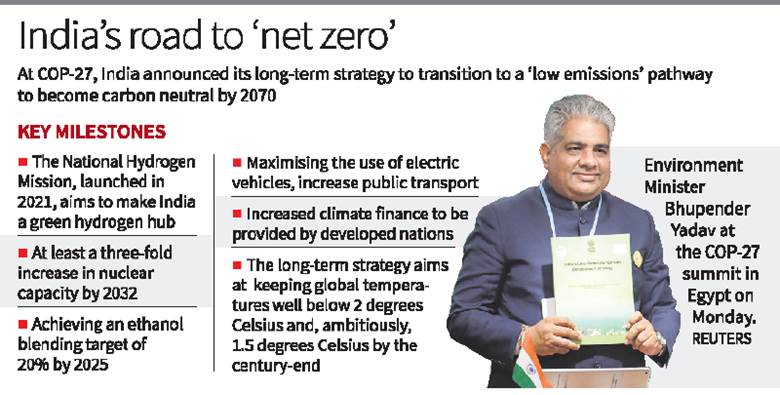- Home
- Prelims
- Mains
- Current Affairs
- Study Materials
- Test Series
 EDITORIALS & ARTICLES
EDITORIALS & ARTICLES
COP27 | Harnessing Education for Effective Climate Action
- Experience of climate-induced disasters and anxiety for the future causes despair in young generation.
- According to Intergovernmental Panel on Climate Change (IPCC), demand-side initiatives can cut greenhouse gas emissions by 40-70 %in 2050.
- Demand-side solution include energy audit, carbon or fuel use tax, renewable energy subsides, coal plant emission standards etc.
- However, apart from demand-side initiatives, education system should be leveraged to both avert climate crises and shape opportunities for the future generation.
- Data by UNESCO (United Nations Educational, Scientific and Cultural Organization) suggests that investments in primary and secondary education for environment will be net positive for public finance in the long term.
- Climate-resilient education system will help Indians to move away from vulnerable towards climate agent.
- Forest-dwelling youth can be entrepreneurs in a nature-based economy.
- Children displaced by climate-induced disasters can attain transformative education.
Long-Term Low Emissions and Development Strategies (LT-LEDS)
- It was launched at COP27 by India.
- Priorities will be given to carbon-intensive sectors like electricity, industry and transport.
- It emphasises the role of a Lifestyle for Environment (LiFE) movement.
- LiFE aims towards sustainable consumption and production.
- Recognizes that the behavioural shifts of individuals and development of markets depends on education.
 Problems faced by education sector in climate initiatives
Problems faced by education sector in climate initiatives
- School closure during pandemic has led to deficiency in learning.
- That is reflected through reduced test scores.
- This will impact productivity and per capita income in the long term.
- According to report by Organisation for Economic Co-operation and Development-
- One year of school closures could reduce GDP from 1.1 to 4.7 %by mid-century.
- Impacts of Covid-19 will hinder economic mobility of Indians.
- Extreme heat reduces students’ learning levels and causes physiological harm.
- Schools are temporarily closed for this reason.
- Children’s health is affected due to poor air quality in cities like Delhi.
- Floods can permanently displace families.
- This leads students (often girls) drop out from schools.
- They are being trafficked or forced for child labour due to distressed household incomes.
- Because of increasing disasters, we must prepare infrastructure, content and delivery of the public education system.
- This will protect vulnerable citizens including climate refugees.
- Digital platforms and news don’t help in overcoming education challenges.
- This includes missing out about the information of latest development like reductions in the costs of renewable energy as they often fail to build a widespread understanding of scientific breakthroughs.
Suggestions to improve education for climate change
- At national level, strong framework for climate-resilient education system should be created.
- It must include nutritious food, clean water and school building codes.
- Public school is a source of learning, shelter, clothing, food and community for many people.
- So, it should be developed in most effective manner.
- Design and implementation of education curriculum as well as climate-resilient infrastructures in districts should be based on existing local needs and climate risks.
- Example: Infrastructure such as school are often used as emergency shelters in cyclone-prone areas.
- Government schools in mega-cities that are used as emergency shelters can integrate and empower children.
- According to a report by UNICEF (United Nations International Children''s Emergency Fund)
- India should create a framework for education.
- It should include consultation from educators, students, experts from the humanities and sciences and relevant ministries and departments.
- Students’ mental health should be taken care with emphasis on social and emotional learning.
- Curricula of scientific and technical knowledge along with indigenous and local knowledge should be prepared.
- There is need for climate education across society rather than simply at the primary and secondary levels.
- The current global discussion about the workers (who are working in the carbon-intensive industries) on losing their job is getting significant momentum.
- It is important to retrain such workers in industries that are not aligned with green economy as such industries have limited future.
- Efforts should be made to foster critical thinking rather than rote learning.
- This will help make next generation understand complexity and informed decision.
- Non-government organisations are helping in scrutinization and working close with communities. More such efforts should be made. Some of efforts are
- In buffer zone of Kanha National Park- Baiga and Gond students are learning the potential of integrating biodiversity conservation with regenerative agriculture.
- In Bengaluru youth are taking civic and climate actions like waste management and lake restoration to make city more liveable.
- Regenerative Agricultures is farming practices that benefits in reversing climate change by rebuilding soil organic matter and restoring degraded soil biodiversity.
- These results in carbon reduction and improves water cycle.
Consumer choices, innovation in policy, finance and each aspect of a green economy will be dependent on strong education system which must be resilient to climate change. Short-term approach will lead to address only symptoms rather than root causes and will shift unsustainable demand from one set of finite resources to another. This will change India’s Lifestyle for Environment and will increase civilisational richness to become a model and movement to be followed by the world.









 Latest News
Latest News General Studies
General Studies